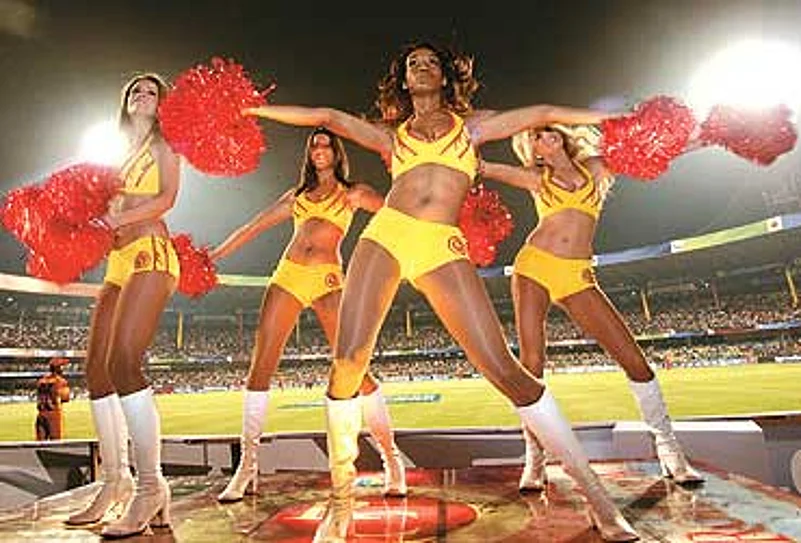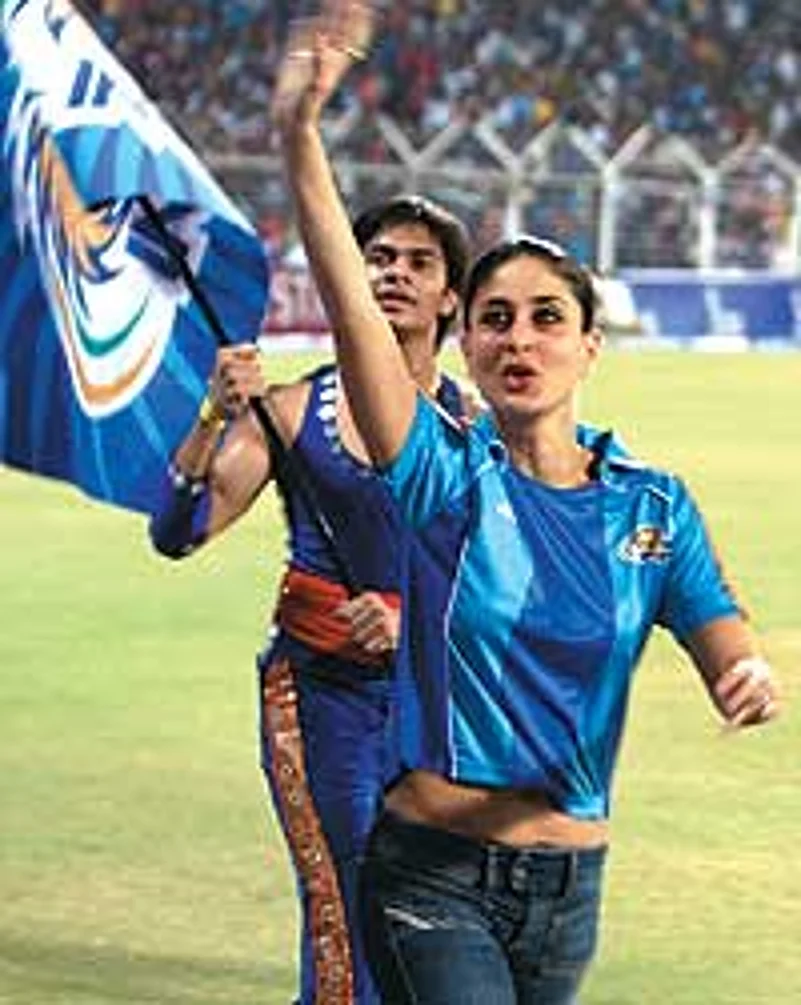Monies From Heaven
Icons
Not up for auction, icon players were assigned to their home cities. Their fees: 15 per cent more than the highest bid player in their team. Jaipur, Chennai and Hyderabad didn’t have icon players.
Top Icon Player
Sachin Tendulkar, Mumbai - Rs 4.49 crore for 3 years
Maximum Auctioned Player
M.S. Dhoni, Chennai - Rs 6 crore for 3 years
Under-19
Each member of India’s 16 U-19 World Cup squad, plus one further U-19 player nominated by the IPL council, gets a fixed fee of Rs 12 lakh for one year. (Eg: Rajasthan’s Ravindra Jadeja)
U-22 and Ranji players
A minimum fee of Rs 8 lakh was fixed for U-22 players (Eg: Bangalore’s K.P.Appanna)
And a minimum of Rs 20 lakh for other Ranji Trophy players (Eg: Chennai’s S. Badrinath)
***

Good lookin’: Washington Redskins do the pom-pom
It's easy to ascribe the buzz around the IPL centres to audiences passionate enough about their teams to buy expensive tickets. But in Delhi, a city of freeloaders, the paying public has been a tiny minority, as is the case in Mumbai. Mohali failed to fill the stadium. Ditto Hyderabad. So, does a poorly attended IPL match reflect an odd host city indifferent to its team's fate? Will stadiums witness a crush if organisers don't dole out passes? Will the eight city teams ever strike an emotional chord strong enough for people to go out, buy tickets repeatedly for IPL matches?
Sure, it's early days but one stark fact has already emerged: the IPL's first week has revealed a flaw that could prove fatal, an identity crisis that looks like it will need the last million dollars of the marketing men to be resolved. There is so much money to be lost if the whole gamble fails that it's become a war to keep the fans hooked—India's own Opium War. As veteran Mumbai journalist Kumar Ketkar told Outlook, "There's so much hype in the press and electronic media, it's like they're trying to push a drug addiction...."
It's a peculiar situation—we have witnessed packed houses, as in Calcutta, but the crowds are not necessarily there for the cricket. They've been seduced by the lights, the firecrackers, the dancing girls (who, predictably, get called "easy" and "sluts"). It's a party in which the cricket has become incidental, where even the media has bought into the glam. "Newspapers are acting like PR agents, filling 3-4 pages with this trivial form of the game. This is when reporters admit privately that this is no cricket," says a senior editor with a Chennai newspaper. "Their writings gush about the cricket as if they've just witnessed a World Cup thriller. There's a strong deviation in what they say about it all in private and what they write."
And what of the cult of celebrity? People will come in to watch Tendulkar or Dhoni, irrespective of whether they're playing for or against their team. So even the minuscule paying public cannot be assumed to be die-hard followers of one team. These initial trends underline the problems of building loyalties around city teams, each of which will spend around Rs 10 crore on marketing and entertainment. But identity is not a function of economics; loyalty can't be thrust on people who don't even know all the players they're supposedly rooting for. Forget the crowd, in last week's match against Chennai, at the post-toss interview, Mumbai's stand-in skipper Harbhajan Singh couldn't remember the names of two players in the playing XI. Is it any wonder then that the war symbolism, inherent in the team names, looks absurd?
The atmosphere was electric in the Mumbai Indians game against the Bangalore Royal Challengers, but Ketkar believes it's not due to any sense of allegiance. "I don't think there's any interest in the team in the city," he says. "Seventy per cent of the stadium was full because of corporate handouts." The litmus test to judge the demand is the requests for passes. "Earlier, I used to request people for passes, for my son or daughter. People used to go to great lengths...," says Ketkar. "Now they (organisers) are begging me to take passes. When I say I want only two for my driver, they're surprised and want to give me another 12!"

| Kareena looks good for Mumbai |
Kings XI Punjab, based in Mohali, is turning out to be a cautionary tale and Sandeep Mehta of Wizcraft, who is building the team's identity in Chandigarh, admits the start has been disappointing. Barely 200 people were in the stands for the opening ceremony before their first game, where Daler Mehndi sang the team anthem, 'Panga na leh'. The bhangra and the dhols weren't much of a draw; neither was Preity Zinta, the team's co-owner. There was a trickle of people as the game went on, but it was a cup half-full, quite a downer at a time when T20 curiosity was at its peak.
Perhaps the team owners erred in mistaking Mohali for Punjab. The team's hub—comprising the proximal tri-cities of Chandigarh, Mohali and Panchkula—considers itself distinct from Punjab or Haryana. "It would have been better if the team had focused on Chandigarh and not Punjab," says Prof Bhupinder Brar of Punjab University. "There's not much evidence of a Punjabi identity in the team." Perhaps a sprinkling of Pakistani Punjabi players would have helped, feels Brar, explaining that a liberalised visa regime between the two nations has kindled a huge interest in youth here for all things Pakistani.
But it isn't as simple, feels social thinker Dr Pramod Kumar. For the imprint of Punjab's geographical position is deep in the mind of the Punjabi; the border state's territorial identity surfaces every time two national teams play, most evident in an India-Pakistan game. There are other issues too—the club concept is alien here; a woman team owner, even if it's a film star, only goes so far in what is a very strongly patriarchal society; and finally, a unanimous view in the region is that a local team without a turbaned Sikh just doesn't get the hormones pumping. (Yuvraj Singh is seen more as an urban Chandigarh kid.)
Anyway, even all of the above may not work. Indians, for all their parochialism, when they think cricket, think of India and not, say, Punjab. Cricket historian Ramachandra Guha says that "Indian cricket can never develop city-based loyalties because national identification is an intrinsic part of the game". The IPL's inaugural game, in fact, confused many and even repulsed some. R. Kannan, secretary of the Karnataka Tenpin Bowling Association, was one such who walked out because he couldn't take the "high-decibel entertainment". Badri Seshadri, founder of cricinfo.com, is convinced that more money won't equal more loyalty. "Loyalties are always built on firm values, and I'm not sure on what basis loyalties will be built in T20 cricket," he told Outlook. "It's funny to see Shahrukh Khan get so excited about Calcutta...he doesn't even belong to the place!"
Shahrukh, though, is pulling in eyeballs, that precious commodity. A contest by website ibibo.com showed the Calcutta team had over thrice the number of supporters than the next team, Mumbai. "We believe it's due to Shahrukh's pan-Indian appeal," says an ibibo.com executive. A mother of a nine-year-old girl in Delhi reports that her daughter and her whole band of girlfriends were supporting the Knight Riders just because of Shahrukh.
In Calcutta too, the team seems to have won the battle for hearts. Which might mean that Calcuttans have the most passionate feelings about their city. Shahrukh's sense of the occasion has helped too—during their second match, as his team faltered against Hyderabad's Deccan Chargers, SRK took the mike and started singing the team anthem; the 90,000-odd spectators joined in, shaking the stadium to its rafters. Asked if he should be called "Dada", SRK assured the local media that the honorific belongs to Sourav Ganguly. "You can call me Khan-da," he quipped. The Bengalis loved it.
Skipper Ganguly is the only big local star in the squad, but the support cuts across all age groups here. Even the hated Ricky Ponting is cheered wildly as 'Ponting-da'. "This city, and state, is quite devoid of heroes. Sourav is one and we desperately need more," says Ranjit Mishra, a sociologist who teaches at Calcutta University. "The Kolkata Knight Riders comes as a good opportunity."
Elsewhere, though, the problem of identity will not be so simple. Most sociologists and political scientists don't have a rosy prognosis for IPL's ambition to build strong regional affinities. Dipankar Gupta of Jawaharlal Nehru University is one exception. Gupta argues on different fields: that club-based support is good for cricket because it ejects jingoism; that a league like the IPL gives more players a living from the game; and that club cricket, with international stars, raises the standard of the game. "Initially, I wasn't very hopeful about IPL, I thought it'd take them 3-4 years to make a mark," Gupta says. "Now I think it might work faster, seeing people watching these games in large numbers."
It's still uncertain exactly who is watching these games, freeloaders or frenzied supporters. The English Premier League model is supposed to be the blueprint, but someone seems to have forgotten that in the epl, it's the quality of football that's of paramount importance. People are not encouraged to look away from the field of action.
A concoction in which cricket is the least important ingredient makes an uncertain potion; the media seems to be lifted by a wave of frenzy worked up by itself. After the first week, it would seem that the man on the street is not going crazy over his city team.

















